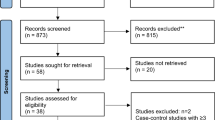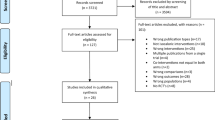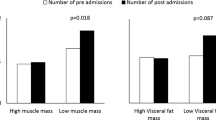Abstract
Background and Objectives
Body composition (BC) assessment in cirrhosis has a wide variety of methods with no consensus on the best tools for each body component in patients with Liver Cirrhosis (LC). We aimed to conduct a systematic scoping review of the most frequent body composition analysis methods and nutritional findings published in liver cirrhosis patients.
Methods
We searched for articles in PubMed, Scopus, and ISI Web of Science databases. Keywords selected the BC methods and parameters in LC.
Results
Eleven methods were found. The most frequently used were computed tomography (CT) 47.5%, Bioimpedance Analysis 35%, DXA 32.5%, and anthropometry 32.5%. Up to 15 BC parameters were reported from each method.
Conclusions
The vast heterogeneity in the results found during the qualitative analysis and imaging methods must reach a consensus to achieve a better clinical practice and improve nutritional treatment, as the physiopathology in LC compromises the nutritional status directly.
This is a preview of subscription content, access via your institution
Access options
Subscribe to this journal
Receive 12 print issues and online access
$259.00 per year
only $21.58 per issue
Buy this article
- Purchase on Springer Link
- Instant access to full article PDF
Prices may be subject to local taxes which are calculated during checkout



Similar content being viewed by others
Data availability
The data generated and analysed during this study can be found within the published article as a Supplementary Online-only file.
References
Nishikawa H, Enomoto H, Ishii A, Iwata Y, Miyamoto Y, Ishii N. et al. Comparison of prognostic impact between the child-pugh score and skeletal muscle mass for patients with liver cirrhosis. Nutrients. 2017;9:595.
Zenith L, Meena N, Ramadi A, Yavari M, Harvey A, Carbonneau M, et al. Eight weeks of exercise training increases aerobic capacity and muscle mass and reduces fatigue in patients with cirrhosis. Clin Gastroenterol Hepatol. 2014;12:1920–6 e2.
Zhou WC, Zhang QB, Qiao L. Pathogenesis of liver cirrhosis. World J Gastroenterol. 2014;20:7312–24.
Parola M, Pinzani M. Liver fibrosis: pathophysiology, pathogenetic targets and clinical issues. Mol Asp Med. 2019;65:37–55.
Roman E, Garcia-Galceran C, Torrades T, Herrera S, Marin A, Donate M, et al. Effects of an exercise programme on functional capacity, body composition and risk of falls in patients with cirrhosis: a randomised clinical trial. PLoS One. 2016;11:e0151652.
Tapper EB, Zhang P, Garg R, Nault T, Leary K, Krishnamurthy V, et al. Body composition predicts mortality and decompensation in compensated cirrhosis patients: a prospective cohort study. JHEP Rep. 2020;2:100061.
Peng S, Plank LD, McCall JL, Gillanders LK, McIlroy K, Gane EJ. Body composition, muscle function, and energy expenditure in patients with liver cirrhosis: a comprehensive study. Am J Clin Nutr. 2007;85:1257–66.
Holland-Fischer P, Nielsen MF, Vilstrup H, Tonner-Nielsen D, Mengel A, Schmitz O, et al. Insulin sensitivity and body composition in cirrhosis: changes after TIPS. Am J Physiol Gastrointest Liver Physiol. 2010;299:G486–93.
Benjamin J, Shasthry V, Kaal CR, Anand L, Bhardwaj A, Pandit V, et al. Characterisation of body composition and definition of sarcopenia in patients with alcoholic cirrhosis: a computed tomography based study. Liver Int. 2017;37:1668–74.
Lurie Y, Webb M, Cytter-Kuint R, Shteingart S, Lederkremer GZ. Non-invasive diagnosis of liver fibrosis and cirrhosis. World J Gastroenterol. 2015;21:11567–83.
Kabbany MN, Conjeevaram Selvakumar PK, Watt K, Lopez R, Akras Z, Zein N, et al. Prevalence of nonalcoholic steatohepatitis-associated cirrhosis in the United States: an analysis of national health and nutrition examination survey data. Am J Gastroenterol. 2017;112:581–7.
Kochanek KD, Murphy SL, Xu J, Tejada-Vera B. Division of Vital Statistics. National Vital Statistics Reports National Center for Health Statistics; 2016. https://www.cdc.gov/nchs/data/nvsr/nvsr65/nvsr65_04.pdf.
Collaborators GBDC. The global, regional, and national burden of cirrhosis by cause in 195 countries and territories, 1990-2017: a systematic analysis for the Global Burden of Disease Study 2017. Lancet. Gastroenterol Hepatol. 2020;5:245–66.
Instituto_Nacional_de_Salud_Publica_(INSP). ¿De qué mueren los mexicanos? Cuernava, Morelos, Mexico: Gobierno de Mexico; 2020. https://www.insp.mx/avisos/5111-dia-muertos-mexicanos.html#:~:text=La%20mayor%C3%ADa%20de%20las%20causas,%25)%20y%20accidentes%20(5.2%25.
Fabbrini E, Sullivan S, Klein S. Obesity and non-alcoholic fatty liver disease: biochemical, metabolic, and clinical implications. Hepatology. 2010;51:679–89.
Cheung K, Lee SS, Raman M. Prevalence and mechanisms of malnutrition in patients with advanced liver disease, and nutrition management strategies. Clin Gastroenterol Hepatol. 2012;10:117–25.
Belarmino G, Gonzalez MC, Sala P, Torrinhas RS, Andraus W, D’Albuquerque LAC, et al. Diagnosing sarcopenia in male patients with cirrhosis by dual-energy X-Ray absorptiometry estimates of appendicular skeletal muscle mass. JPEN J Parenter Enter Nutr. 2018;42:24–36.
Anand AC. Nutrition and muscle in cirrhosis. J Clin Exp Hepatol. 2017;7:340–57.
Hara N, Iwasa M, Sugimoto R, Mifuji-Moroka R, Yoshikawa K, Terasaka E, et al. Sarcopenia and sarcopenic obesity are prognostic factors for overall survival in patients with cirrhosis. Intern Med. 2016;55:863–70.
Nishikawa H, Enomoto H, Iwata Y, Nishimura T, Iijima H, Nishiguchi S. Clinical utility of bioimpedance analysis in liver cirrhosis. J Hepatobiliary Pancreat Sci. 2017;24:409–16.
Plauth M, Schutz T, Buckendahl DP, Kreymann G, Pirlich M, Grungreiff S, et al. Weight gain after transjugular intrahepatic portosystemic shunt is associated with improvement in body composition in malnourished patients with cirrhosis and hypermetabolism. J Hepatol. 2004;40:228–33.
Plauth M, Bernal W, Dasarathy S, Merli M, Plank LD, Schutz T, et al. ESPEN guideline on clinical nutrition in liver disease. Clin Nutr. 2019;38:485–521.
Rivera-Sotelo N, Vargas-Del-Angel RG, Ternovoy SK, Roldan-Valadez E. Global research trends in COVID-19 with MRI and PET/CT: a scoping review with bibliometric and network analyses. Clin Transl Imaging. 2021;9:625–39.
Arksey H, O’Malley L. Scoping studies: towards a methodological framework. Int J Soc Res Methodol. 2005;8:19–32.
Tricco AC, Lillie E, Zarin W, O’Brien KK, Colquhoun H, Levac D, et al. PRISMA extension for scoping reviews (PRISMA-ScR): checklist and explanation. Ann Intern Med. 2018;169:467–73.
Guzman-Ortiz E, Bueno-Hernandez N, Melendez-Mier G, Roldan-Valadez E. Quantitative systematic review: methods used for the in vivo measurement of body composition in pregnancy. J Adv Nurs. 2021;77:537–49.
Fraser KT, Shapiro S, Willingham C, Tavarez E, Berg J, Freudenberg N. What we can learn from U.S. food policy response to crises of the last 20 years - lessons for the COVID-19 era: a scoping review. SSM Popul Health. 2022;17:100952.
Toglia J, Goverover Y. Revisiting the dynamic comprehensive model of self-awareness: a scoping review and thematic analysis of its impact 20 years later. Neuropsychol Rehabil. 2022;32:1676–725.
Fosbol MO, Zerahn B. Contemporary methods of body composition measurement. Clin Physiol Funct Imaging. 2015;35:81–97.
MacFie J, Burkinshaw L. Body composition in malignant disease. Metabolism. 1987;36:290–4.
Morgan MY, Madden AM, Jennings G, Elia M, Fuller NJ. Two-component models are of limited value for the assessment of body composition in patients with cirrhosis. Am J Clin Nutr. 2006;84:1151–62.
Tosato M, Marzetti E, Cesari M, Savera G, Miller RR, Bernabei R, et al. Measurement of muscle mass in sarcopenia: from imaging to biochemical markers. Aging Clin Exp Res. 2017;29:19–27.
Campillo B, Richardet JP, Scherman E, Bories PN. Evaluation of nutritional practice in hospitalised cirrhotic patients: results of a prospective study. Nutrition. 2003;19:515–21.
Figueiredo FA, Perez RM, Freitas MM, Kondo M. Comparison of three methods of nutritional assessment in liver cirrhosis: subjective global assessment, traditional nutritional parameters, and body composition analysis. J Gastroenterol. 2006;41:476–82.
Ruiz-Margain A, Macias-Rodriguez RU, Duarte-Rojo A, Rios-Torres SL, Espinosa-Cuevas A, Torre A. Malnutrition assessed through phase angle and its relation to prognosis in patients with compensated liver cirrhosis: a prospective cohort study. Dig Liver Dis. 2015;47:309–14.
Schwaiger E, Simon A, Wabel P, Schairer B, Berner C, Signorini L, et al. Bioimpedance spectroscopy for fluid status assessment in patients with decompensated liver cirrhosis: Implications for peritoneal dialysis. Sci Rep. 2020;10:2869.
Yao J, Zhou X, Yuan L, Niu LY, Zhang A, Shi H, et al. Prognostic value of the third lumbar skeletal muscle mass index in patients with liver cirrhosis and ascites. Clin Nutr. 2020;39:1908–13.
Paternostro R, Lampichler K, Bardach C, Asenbaum U, Landler C, Bauer D, et al. The value of different CT-based methods for diagnosing low muscle mass and predicting mortality in patients with cirrhosis. Liver Int. 2019;39:2374–85.
Hou L, Deng Y, Fan X, Zhao T, Cui B, Lin L, et al. A sex-stratified prognostic nomogram incorporating body compositions for long-term mortality in cirrhosis. JPEN J Parenter Enter Nutr. 2021;45:403–13.
Yoo JJ, Kim SG, Kim YS, Lee B, Lee MH, Jeong SW, et al. Estimation of renal function in patients with liver cirrhosis: Impact of muscle mass and sex. J Hepatol. 2019;70:847–54.
Bello-Chavolla OY, Antonio-Villa NE, Vargas-Vazquez A, Viveros-Ruiz TL, Almeda-Valdes P, Gomez-Velasco D, et al. Metabolic Score for Visceral Fat (METS-VF), a novel estimator of intra-abdominal fat content and cardio-metabolic health. Clin Nutr. 2020;39:1613–21.
Alvares-da-Silva MR, Reverbel da Silveira T. Comparison between handgrip strength, subjective global assessment, and prognostic nutritional index in assessing malnutrition and predicting clinical outcome in cirrhotic outpatients. Nutrition. 2005;21:113–7.
Figueiredo FA, De Mello Perez R, Kondo M. Effect of liver cirrhosis on body composition: evidence of significant depletion even in mild disease. J Gastroenterol Hepatol. 2005;20:209–16.
Zavaglia C, Brivio M, Losacco E, Onida L. [The dietary protein contribution and hepatic encephalopathy in cirrhosis]. Recent Prog Med. 1992;83:218–23.
Lehnert ME, Clarke DD, Gibbons JG, Ward LC, Golding SM, Shepherd RW, et al. Estimation of body water compartments in cirrhosis by multiple-frequency bioelectrical-impedance analysis. Nutrition. 2001;17:31–4.
Belarmino G, Gonzalez MC, Torrinhas RS, Sala P, Andraus W, D’Albuquerque LA, et al. Phase angle obtained by bioelectrical impedance analysis independently predicts mortality in patients with cirrhosis. World J Hepatol. 2017;9:401–8.
Sung JH, Uojima H, Hidaka H, Tanaka Y, Wada N, Kubota K, et al. Risk factors for loss of skeletal muscle mass in patients with cirrhosis. Hepatol Res. 2019;49:550–8.
Uojima H, Sakurai S, Hidaka H, Kinbara T, Sung JH, Ichita C, et al. Effect of branched-chain amino acid supplements on muscle strength and muscle mass in patients with liver cirrhosis. Eur J Gastroenterol Hepatol. 2017;29:1402–7.
Namba M, Hiramatsu A, Aikata H, Kodama K, Uchikawa S, Ohya K, et al. Management of refractory ascites attenuates muscle mass reduction and improves survival in patients with decompensated cirrhosis. J Gastroenterol. 2020;55:217–26.
Kirpich IA, Solovieva NV, Leikhter SN, Shidakova NA, Lebedeva OV, Sidorov PI, et al. Probiotics restore bowel flora and improve liver enzymes in human alcohol-induced liver injury: a pilot study. Alcohol 2008;42:675–82.
Szabo G. Gut-liver axis in alcoholic liver disease. Gastroenterology. 2015;148:30–6.
Slim K, Nini E, Forestier D, Kwiatkowski F, Panis Y, Chipponi J. Methodological index for non-randomised studies (minors): development and validation of a new instrument. ANZ J Surg. 2003;73:712–6.
Bonefeld K, Hobolth L, Juul A, Moller S. The insulin like growth factor system in cirrhosis. Relation to changes in body composition following adrenoreceptor blockade. Growth Horm IGF Res. 2012;22:212–8.
Kobayashi K, Maruyama H, Kiyono S, Ogasawara S, Suzuki E, Ooka Y, et al. Application of transcutaneous ultrasonography for the diagnosis of muscle mass loss in patients with liver cirrhosis. J Gastroenterol. 2018;53:652–9.
Praktiknjo M, Book M, Luetkens J, Pohlmann A, Meyer C, Thomas D, et al. Fat-free muscle mass in magnetic resonance imaging predicts acute-on-chronic liver failure and survival in decompensated cirrhosis. Hepatology. 2018;67:1014–26.
Sinclair M, Chapman B, Hoermann R, Angus PW, Testro A, Scodellaro T, et al. Handgrip strength adds more prognostic value to the model for end-stage liver disease score than imaging-based measures of muscle mass in men with cirrhosis. Liver Transpl. 2019;25:1480–7.
Acknowledgements
AJEF was a research fellow at the Directorate of Research in HGMEL during 2020–2022. AJEF was supported by the Consejo Nacional de Ciencia y Tecnologia (CONACyT), Mexico fellowship award. This work was submitted in partial fulfilment of the requirements for the MSc degree of AJEF at the Programa de Maestria en Ciencias de la Salud, Escuela Superior de Medicina, Instituto Politecnico Nacional, Mexico. This research received no specific grant from any funding agency in the public, commercial, or not-for-profit sectors.
Author information
Authors and Affiliations
Contributions
Conceptualisation, AJEF, EGO, and ERV; methodology, AJEF, EGO, and ERV; software AJEF, EGO and ERV; Validation, AJEF, EGO, NBH, ERV, GMM, and SKT; formal analysis, AJEF, EGO, NBH, ERV, GMM, and SKT; investigation, AJEF, and EGO; resources, ERV; data curation AJEF and EGO; writing—original draft preparation, AJEF, EGO, NBH, ERV, GMM, and SKT; writing—review and editing, AJEF, EGO, NBH, ERV, GMM, and SKT; visualisation, AJEF, EGO, NBH, ERV, GMM, and SKT; supervision, ERV; project administration, ERV; funding acquisition, NA. All authors have read and agreed to the published version of the manuscript.
Corresponding authors
Ethics declarations
Competing interests
The authors declare no competing interests.
Ethical approval
Because this study is a scoping review of publicly available information from medical literature, ethical approval was not required for this manuscript.
Additional information
Publisher’s note Springer Nature remains neutral with regard to jurisdictional claims in published maps and institutional affiliations.
Supplementary information
Rights and permissions
Springer Nature or its licensor (e.g. a society or other partner) holds exclusive rights to this article under a publishing agreement with the author(s) or other rightsholder(s); author self-archiving of the accepted manuscript version of this article is solely governed by the terms of such publishing agreement and applicable law.
About this article
Cite this article
Espinosa-Flores, AJ., Guzman-Ortiz, E., Melendez-Mier, G. et al. A scoping review of the methods used in patients with liver cirrhosis to assess body composition and their nutritional findings. Eur J Clin Nutr 77, 845–854 (2023). https://doi.org/10.1038/s41430-023-01287-7
Received:
Revised:
Accepted:
Published:
Issue Date:
DOI: https://doi.org/10.1038/s41430-023-01287-7



